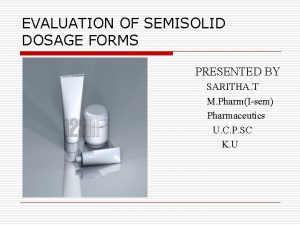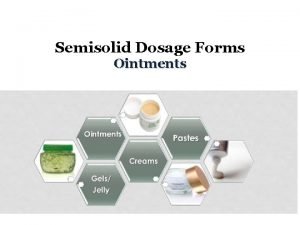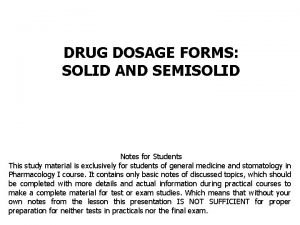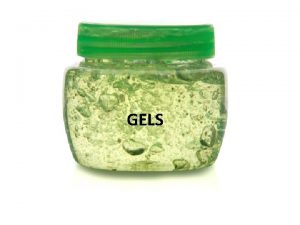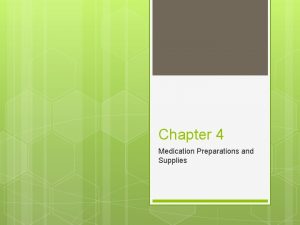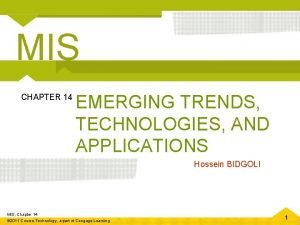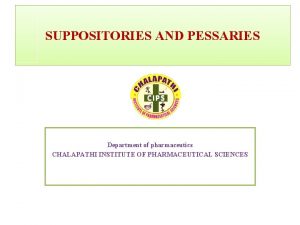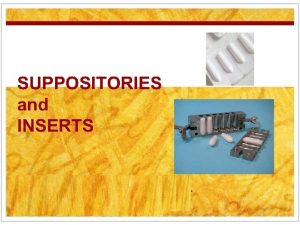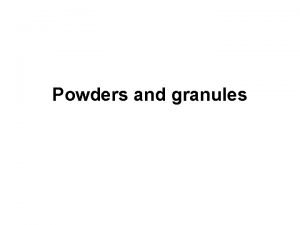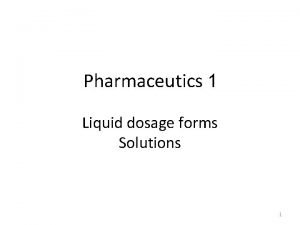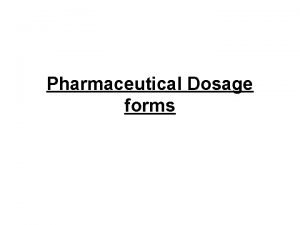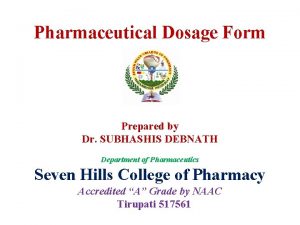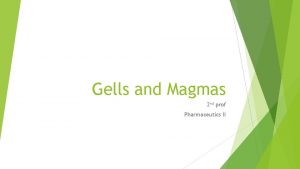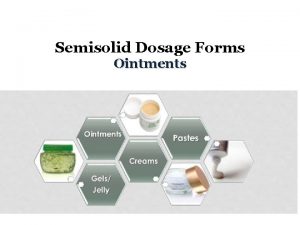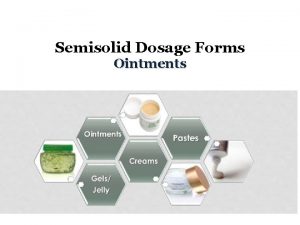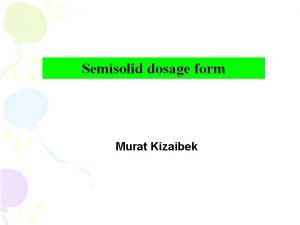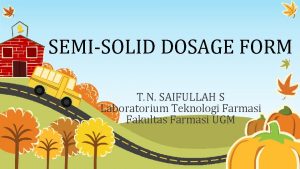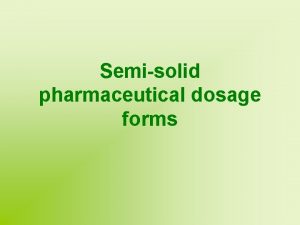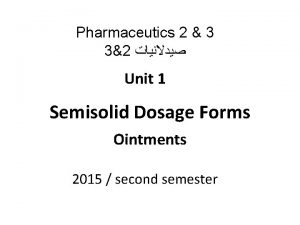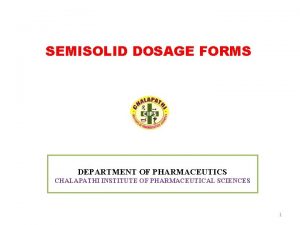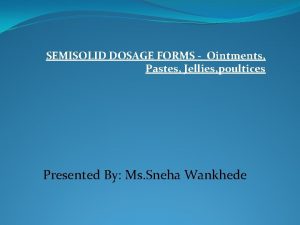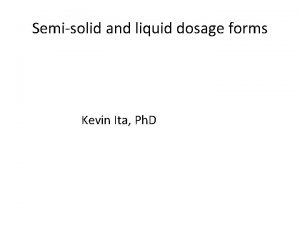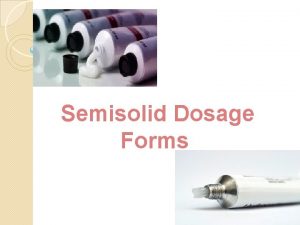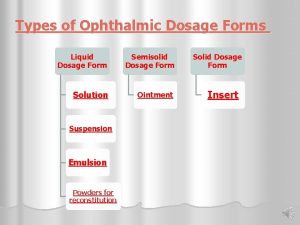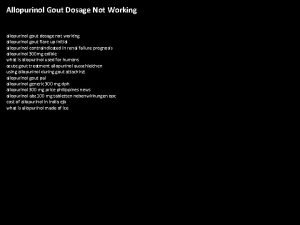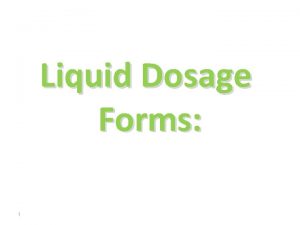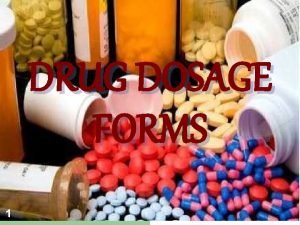INNOVATION IN SEMISOLID DOSAGE FORM INTRODUCTION A recent



































- Slides: 35

INNOVATION IN SEMISOLID DOSAGE FORM

INTRODUCTION • A recent advances in semisolid dosage form allows modified release as well as flexibility in route of administration

NOVEL SEMISOLIDS • Novel semisolids are made up from water washable bases so they cause less irritation to skin and are superior to conventional semisolid dosage form. • Novel creams are provided with nanoparticles and microspheres which has an excellent emollient effect , with better spreadibility and less staining.

• Innovations in gels in terms of modification of release pattern • • • Complex gels for insulin delivery Chitosan based bioadhesive gels TIMERX technology for controlled release Amphiphilic gels non aqueous gels

• Number of new bases for gels, ointments and creams are developed which facilitates the delivery of above novel semisolids by various route like nasal , parenteral and ophthalmic.

IDEAL PROPERTIES OF NOVEL SEMISOLIDS • NOVEL OINTMENT BASES • Absorb more water and enhance permeation • Form film over skin which prevents evaporation of moisture • Not irritate skin • Novel semisolids are safe even when applied to inflammed skin

• They should be odorless, easy to handle, stable and compatible with large range of drugs • Use of that in pediatric, geriatrics and pregnant women should be safe. • They should extend the release pattern in a contrlled manner. • They allow their use in different routes of administration.

NOVEL ADVANCES IN SEMISOLID DOSAGE FORM OINTMENTS • RECTAL OINTMENTS • It is used for the symptomatic relief against anal and peri anal pruritus, pain and inflammation associated with hemorrhoids , anal fissure, fistules and proctitis. • Modern ointment bases • modified london-zopf base • carbopol • glyceryl mono stearate

CREAMS • CREAMS CONTAINING MICROSPHERE • Albumin microsphere containing vitamin A can be administered by using cream topically. • 200 -250 micron size of microsphere of vit. A were produced by emulsion method. • In VIVO study revealed that these microsphere were able to remain on the skin for a long period of time and so they prolong the release of vit A

LAMELLAR FACED CREAMS • They are liquid paraffin in water emulsion prepared from cetrimide/fatty alcohol like mixed emulsifier and ternary system formed by dispersing the mixed emulsifier in required quantity of water. • The cationic emulsifying wax showed phenomenal swelling in water due to electrostatic repulsion which can be suppressed by addition of salt and can be reduced by changing surfactant counter ion.

CREAM CONTAINING LIPID NANOPARTICLES • Occlusion of cream is important criteria since it increases the penetration of topical drugs. • This can be achieved by using oils and fats like liquid and semisolid paraffin in large quanties. • A high degree of occlusivity was obtained with smooth , flexible films prepared by drying aqueous dispersion of solid parafffin particles with a mean size of 200 nm. • However, this nanodispersion revealed a rough texture when applied.

• The development of a w/o cream where in the aqueous phase was divided into small droplets solved this problem. • Nanoparticles were incorporated in the aqueous phase. Hence, the oil phase in which the water droplets were dispersed serve as a lubricant for nanoparticles , thereby preventing rough feel during application.

GELS • CONTROLLED RELEASE GELS • Gel formulation with suitable rheological and mucoadhesive properties increase the contact time at the site of absorption. • It was possible to control the release of uncharsed drug substances by including surfactants that form micelles in the gels. • The release depends on lipophilic interactions between the drug and the polymer and/or the micells.

• Controlled release formulation of charged drugs could be designed by mixing the drugs with oppsitely charsed surfactant in certain fixed ratio. • In this way, vesicles in which the drug and surfactant constituted the bilayer formed spontaneously. Vesicles formation was affected by the presence of polymer. • Small vesicles gave a slow release rate when a lipophilically modified polymer was used.

ORGANOGELS • Sorbitan monostearate, a hydrophobic nonionic surfactant, gels a number of organic solvents such as hexadecane , isopropyl myristate and a range of vegetable oils. • Organogels have potential applications as delivery vehicles for drugs and antigens.

PREPARATION OF ORGANOGELS • Gelation is achieved by dissolving the organogelator in hot solvent to produce an organic solution which on cooling sets to gel state. • Cooling the solution causes the decrease the solventgelator affinity. • At the gelation temperature the surfantant molecules self assemble into toroidal inverse vesicle.

• Further cooling results in the conversion of toroids into rod tul is bules. • Once formed, the tubules associate with other and 3 – dimensional network is formed which immobilizes the solvent and organogel is thus formed.

Extended release gel • TIMERx is controlled release technology consist of an agglomerated, hydrophilic complex when compressed forms control release matrix. • The matrix consist of xanthan and locust bean gums combnied with dextrose surrounds a drug core. • In the presence of water, interaction between matrix components form a tight gel while the inner core remain unwetted

• Thus, the gel matrix control the release until the matrix erodes • Advantages • Predictable modified release profile like zero order or first order. • It can be manufacture on standard manufacturing equipment • cheap

Amphiphilic gels • It can be prepared by mixing the solid gelator like sorbitan monostearate or sorbitan monopalmitate and the liquid phase like polysorbat or sorbitan ester and heating them at 60 c to form clear isotropic solution phase and cooling the solution phase to form opaque semi solid at room temperature. • It consisted mainly of clusters of tubules of gelator molecules that had aggregated upon cooling of the solution phase forming

At the skin surface temperature the gel softened considerably this would allow the topical application

Hydrophilic gel • Hydrophilic gelsare bicoherent systems composed of internal phase made of polymer producing a coherent 3 - d net like structure which fixes the liquid vehicle as the external phase. • Inter molecular forces bind the molecules of solvent to the polymeric net thus decrease the mobility of this molecule and producing a structure system with increased viscosity

• Pharmaceutical research now concentrate primarily on hydrophilic gels, as this dosage form seems to be prospective for the development of modern drugs based on systems with prolonged and controlled release of active ingradients

Bioadhesive gels • Chitosan bioadhesive gel was formulated for nasal delivery of insulin. • The gels contained 4000 Iu/dl insulin, 2 or 4 % of low or medium mol. Weight of chitosan and lecithin or EDTA. • Drug release studied by membraneless diffusion method and bioadhesion by modified tensiometry test. • Formulation containing 2 % of low mol. Weight of chitosan with EDTA had higher release percentage and dissolution

Complexation gels • The use of ph responsive, poly (methacrylic-g-ethylene glycol)hydrogels as oral delivery vehicles for insulin were evaluated • Insulin was loaded into polymeric microspheres and administered orally • In te acidic enviornment of the stomach, the gel remains unswollen due to formation of intermolecular polymer complexes. the insulin remain in the gel and was protected from proteolytic

Thrmosensitive sol-gel resevesible hydrogel • They are aqueous polymeric solution which undergo reversible sol to gel transformation under the influence of environmental condition like temp. and ph which results in in situ hydrogel formation. • Advantages • Convenient to administer • Release can be in controlled fashion

Novel advance in semi solid applications • Nasal route Drug delivery to nasal mucosa for either local or systemic action faces obstacles like cilia, mucus. advantages lower dose rapid local therapeutic effect rapid systemic therapeutic blood level

• Uses • In addition to nasal decongesatants, saline and other routine locally acting drugs, nasal administration is being investigated for the delivery of insulin, vaccines, no. of polypeptides and proteins. • E. g. vit. B 12 nasal gel increase the six fold blood level than vit B 12 tablets.

Opthalamic • In occular drug delivery many physiological consraints prevent the succesful drug delivery to eye. Drug loss occur • 1) less capacity of cualdy sac • 2)dilution of drug due to lachrymal secretion • 3)nasolachrymal drainage • So formulation administrated by increasing the viscosity of dosage form.

• Uses • Wide range of eye ointment available in market. • E. g. acyclovir eye ointment • chloramphenicol ophthalmic ointment Formulation Ophthamlic pharmaceutical composition including buffers, surfcantant, stabiliser, preservatives, ophthalmic wetting agent and ophthamlic diluting agent

Rectal route • It includes ointment, cream, gel for application to perianal area. • Advantages • Large surface area • By pass First pass hepatic metabolism • Prolong residence time • Permeability to large mol. Weight drugs such as peptide and protiens. • Insulin gel administrated deep rectally

Marketed formulation • Anusol (starch) • Tronolan (pramoxin hcl)

References • Swarbrick J, Boylan J. C, Encyclopedia of pharmaceutical Technology, Vol. 14, 1996. Marcel Deckker Inc. 31 – 59 • Lachman L, Libberman H. A, Kanig J. L, Theroy and practice of Industrial pharmacy. 4 th edition. 1991, Verghese Publishing House. 534 – 563 • Remington, The science and practice of pharmacy. Vol. 1. 19 th edition. 1995. 304 310

• Euro. J. pharma. Biopharma Vol. 50. No. 1 July 3. 2000. 27 – 46 • Banker G. S. , Rhodes C. T. , Modern Pharmaceutics. Vol. 7. 1979. Marcel Deckker 272 - 276

The way to get started is to quit talking & being doing. . – Walt Disney.
 Semi solid dosage form definition
Semi solid dosage form definition Definition of dosage form
Definition of dosage form Classification of semisolid dosage form
Classification of semisolid dosage form Semisolid dosage form definition
Semisolid dosage form definition Manufacturing of pharmaceutical of semisolid dosage forms
Manufacturing of pharmaceutical of semisolid dosage forms Mysite socccd
Mysite socccd Radical innovation vs disruptive innovation
Radical innovation vs disruptive innovation Glycerogelatins
Glycerogelatins Sterile semisolid preparations for ophthalmic use only are
Sterile semisolid preparations for ophthalmic use only are Introduction to innovation
Introduction to innovation Recent trends in ic engine
Recent trends in ic engine Recent developments in ict
Recent developments in ict Recent developments in object detection
Recent developments in object detection Many recent college graduates have faced
Many recent college graduates have faced Explain recent trends in foreign trade of india
Explain recent trends in foreign trade of india Skimming techniques include
Skimming techniques include Modern trends in project management
Modern trends in project management Recent demographic changes in the uk
Recent demographic changes in the uk Myips schoology login
Myips schoology login Geotaphonomy
Geotaphonomy In a recent car accident tamiko
In a recent car accident tamiko A friend emails you the results
A friend emails you the results Recent advances in ceramics
Recent advances in ceramics Passive headlines
Passive headlines Https drive google com
Https drive google com Udin login
Udin login Mis trends
Mis trends Https drive google com drive u 0 recent
Https drive google com drive u 0 recent Emulsifying bases
Emulsifying bases Preparation of suppositories
Preparation of suppositories Powder dosage form example
Powder dosage form example Elixir dosage form example
Elixir dosage form example Define dosage form in pharmaceutics
Define dosage form in pharmaceutics Dosage form definition
Dosage form definition Classification of liquid dosage form
Classification of liquid dosage form Magmas dosage form
Magmas dosage form
